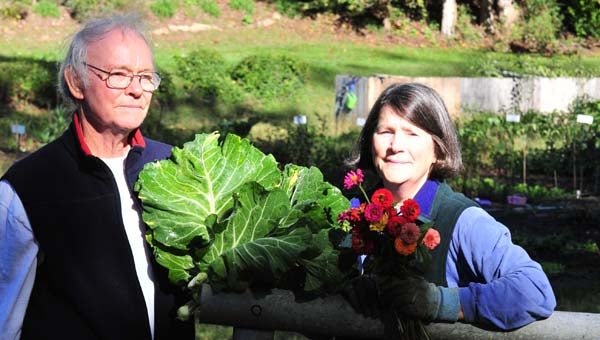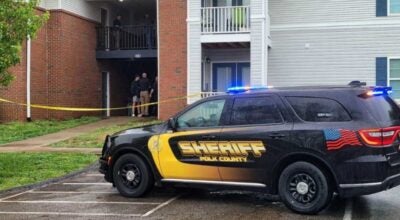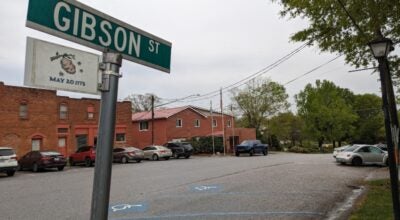Growing, learning, sharing at Saluda Community Garden
Published 10:00 pm Friday, October 9, 2015

Walter Hoover, left, and Beth Carson are two of the many gardening enthusiasts who enjoy working the soil at the Robinson Garden (Saluda Community Garden) at Henderson and Poplar Streets, Saluda. Hoover displays some of his Portuguese kale, while Carson holds some of her zinnias. (Photo by Mark Schmerling)
At least six years ago, community minded individuals with the love of gardening as a common thread formed the Saluda Community Garden, more correctly, the Robinson Garden sponsored by Saluda Community Land Trust and Polk County Community Foundation.
“The big thing,” said master gardener Walter Hoover, who raises exemplary crops on two to three of the garden’s plots, “is that the Robinsons (Pat and Mark) have been willing to lease this land to the land trust. Community is the operative word,” Hoover added regarding the varied participation and the donation of some of the produce to other gardeners.
The Robinson Garden is located in a fertile plot of open land at Henderson and Poplar Streets.
“It’s a great place for the citizens of Saluda to garden,” Hoover emphasized, noting, “The land trust is about community.”
Initially, the garden had no watering system, until SCLT official Dave Prudhomme devised and helped install an effective system that has greatly reduced gardeners’ labor. That system was especially welcome this past summer, when rain was scarce.
Beth Carson likes the location because her home, located in nearby wooded terrain, offers insufficient sunshine for growing her treasured zinnias.
While the garden provides a common place for many individuals, it also attracts the attention of passersby.
“People slow down to see what’s happening in the garden,” Hoover said. Indeed, shortly after this observation, a young woman walking her dog stopped and asked for recommendations on plants to use as ground cover in shaded areas near her home. Hoover, Carson and Kay McCord, another gardening enthusiast who has a plot there, were eager to share advice, without appearing authoritative.
Hoover noted that when he travels, he searches out community gardens, to see how it’s done, and to observe crops unfamiliar to him. At a community garden in Portugal, Hoover saw Portuguese kale, the leaves of which visually resemble collard greens. This summer and extending into early autumn, Hoover produced a fine crop of this variety of kale.
Carson raised crops the first year this garden operated.
“If you take on a plot,” Carson continued, “it makes you aware of the challenges farmers face.”
Of the soil on this property, Carson added, “It’s been wonderful soil.”
The field, actually rich bottomland at the very head of an Atlantic Ocean-draining watershed, was tended for years by Bud Allman. Hoover described the soil as clay/loam, with plenty of organic matter, improved through the years by gardeners.
Making the soil even richer are leaves that blow in and settle there. “It’s a naturally-productive area,” Hoover observed.
Of course, while collecting nutrients, bottomland also gets frosted earlier than nearby spots at higher elevation. Gardeners in the Saluda area have made note of a variety of micro-climates.
Hoover created a hoop house to keep frost off crops of early green beans. Other gardeners have learned to adapt to local conditions.
“You do take advantage of those micro-climates,” Hoover said. “This town is full of them, with variations coming from tree cover or lack of it, winds, or lack of them, and different elevations.”
First frost date in this part of Saluda is usually mid-October.
While Robinson Garden members have much in common, they are also distinguished by their points of geographic origin.
Hoover, a native of the South Carolina Low Country, favors butter beans and Crowder peas, though he raises much other produce. When McCord, who hails from North Dakota, thinks gardening, she thinks “potatoes and rhubarb,” although her talents result in good crops of other produce, including this year’s green peppers.
Carson, who has lived in various parts of North Carolina, loves zinnias, which she says are her mom’s favorite flower. She grew up with the same North Carolina Piedmont crops as Walter—corn, butter beans, and strawberries.
Hoover noted that Bruce Hunt, another enthusiast with a plot in the garden, raises good crops of sweet potatoes and cabbage.
A challenge facing many gardeners, including those at Robinson Garden, is to produce as much as possible in a limited area.
Hoover and others do this by starting with cool weather crops fairly early in the year, then shifting to warm or hot weather crops for the summer, and maybe planting a cool-weather crop by late summer or early fall.
One year, members of the nearby Methodist Church grew food, which they donated to a local food bank. Gardeners also share their excess production with fellow gardeners.
Other benefits of working one or more of these plots, noted Carson, include eating healthy food, and getting exercise while raising it.
It’s also a place for education, McCord noted. “It’s a great way to learn gardening from the other people around.”
Added Hoover, “There’s a lot of interaction that allows people to learn stuff.”
Each garden plot is about 20-by-20 feet, though some narrow strips are available for rent. Some gardeners, like Hoover, invest in multiple plots, which prompts higher yields (and additional work). The garden is shut down from December through February, re-opening in early March.
Each January or February, a notice is posted in Cathy Jackson’s Saluda Lifestyles and in the Tryon Daily Bulletin, noting a meeting date and place, where those interested in renting (or keeping their existing) plot or plots can attend. Rental fee for a 20-by-20 foot plot is $30.





